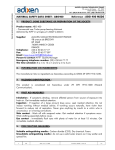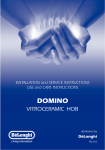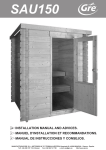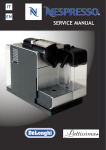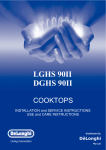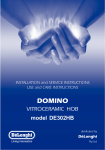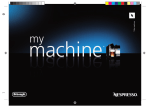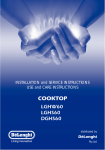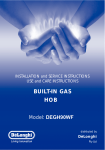Download ceramic COOKTOPS
Transcript
LCH ceramic COOKTOPS INSTALLATION and SERVICE INSTRUCTIONS USE and CARE INSTRUCTIONS distributed by DèLonghi Pty Ltd Use and Care INSTALLATION CAUTION: < In order to avoid a hazard this appliance must be installed according to these instructions for installation. WARNING: < This appliance is to be installed only by an authorised person. < This appliance must be used only for the task it has explicitly been designed for, that is for cooking foodstuffs. Any other form of usage is to be considered as inappropriate and therefore dangerous. < Do NOT place combustible materials or products on this appliance at any time. < Do NOT spray aerosols in the vicinity of this appliance while it is in use. TECHNICAL INFORMATIONS: Triple circuit hotplate Triple circuit hotplate Triple circuit hotplate “ON” indicator light Hotplate and residual heat indicator Glass overheat cut-out device Voltage Maximum absorbed power 145 1200-1300 W 180 1700-1850 W 195 1900-2050 W nr. 2 nr. 1 nr. 1 nr. 1 nr. 4 nr. 1 230-240 V~ / 400-415 V 3N~ 50 Hz 6000 - 6500 W DIMENSIONS (Table 2): (Note: Also refer to Figure 1 side) General Dimensions Width Depth Depth Below Mounting Surface Cut-out Dimensions Width Depth 2 575 mm 505 mm 52 mm 560 mm 490 mm Figure 1 575 52 505 49 560 0 CLEARANCES: Installation clearances and protection of combustible surfaces shall comply with page 4. 750 mm 450 mm Figure 2 3 Use and Care The installation shall comply with the dimensions in Figures 1 and 2, bearing in mind that: < A minimum clearance of 40 mm has to be kept between the bottom of the cooking hob and the top af an appliance or a thermal barrier (see next page). < Overhead clearances - In no case shall the clearances between the highest part of the hob and a range hood be less than 600 mm, or for an overhead axhaust fan, 750 mm. Any other downward facing combustible surface less than 600 mm above the highest part of the hob shall be protected for the full width and depth of the cooking surface area. However, in no case shall this clearance to any surface be less than 450 mm. < Side clearances - Where the dimension from the periphery of the nearest hotplate to any vertical combustible surface is less than 200 mm, the surface shall be protected to a height of not less than 150 mm above the hob for the full dimension (width or depth) of the cooking surface area. < Protection of combustible surfaces - The required protection shall ensure that the surface temperature of the combustible surface does not exceed 50°C above ambient. The fixing of 5 mm tick ceramic tiles to the surface or attaching fire resistant material to the surface and covering with sheet metal with minimum tickness of 0,4 mm would satisfy this requirement. CAUTION : The underside surface of the cooking hob can reach a temperture exceeding 105°C during normal use. If after installation the underside surface is accessible throught under-bench cupboard doors and the like, it is essential that a rigid barrier is installed so that such access is restricted. In order to avoid a hazard the barrier must be of low thermal conductivity material installed according to the instructions for installation. 4 THERMAL BARRIER INSTALLATION : WARNING: < If the hob is installed over drawers or cupboards, a thermal protection barrier must be fitted at least 40 mm beneath the base of the hob (see Figure 3). Note: < Above not applicable if hob is mounted directly above an oven. < For access to the hob for servicing or installation, ensure that the barrier can be removed from beneath by the use of a tool. < A gap of 20 mm may be allowed at rear for electrical connection and ventilation 40 mm 40 mm THERMAL PROTECTION BARRIER (min 15 mm thick) Fitted the full lenghts of the hob below the workbench and must be removable with the use of a tool for installation and service. Figure 3 5 INSTALLATION : < Apply the adhesive seal around the edge of the hob ensuring that the ends do not overlap or leave a space (Figure 4). < Slot in the cooking hob into the cut out of the workbench and locate it correctly. < Adjust the clamps according to the worktop tickness (30 or 40 mm - see Figure 5) and tighten the fixing screws until the hob is firmly secured. < Using a sharp tool, trim any excess gasket which protrudes from the edge of the hob. Figure 4 Adhesive side 6 4 cm 4 cm min 4 cm min 3 cm Figure 5 ELECTRICAL REQUIREMENTS : WARNING : < THIS APPLIANCE MUST BE EARTHED. < In order to avoid a hazard this appliance must be installed according to these instructions for installation. CAUTION : < Ensure that the power outlet is properly earthed before connecting the appliance. < Disconnect power before servicing the appliance. A double pole switch must be provide do not further than 2 metres from the appliance to the electrical supply. All supply current and earth conductors must be able to withstand an ambient temperature of 75°C. The wires in the power cable must be coloured in accordance with the following code : Green/Yellow = Earth, Blue = Neutral, Brown =Active or Live. FEEDER CABLE SECTION 230-240 V ~ 230-240 V 3 ~ 400-415 V 3N~ 3 x 4 mm2 (*) 4 x 2,50 mm2 (*) 5 x 1,50 mm2 (*) (*) - Connection with wall box Figure 6 230-240 V~ 1 2 3 4 5 L1 230-240 V 3~ 1 2 3 4 5 N (L2) E L1 L2 L3 E 400-415 V 3 N~ 1 2 3 4 5 L1 L 2 L 3 N E 7 ELECTRIC DIAGRAM M 5 4 3 2 1 F1 P2 P1 T0 P3 P2 P2 P1 P1 5 4 3 2 1 F2 P3 P2 P2 P1 P1 GS 5 4 3 2 1 F3 P3 P2 P2 P1 P1 P3 5 4 P4 3 2 1 P3 P2 P2 P1 P1 S ELECTRIC DIAGRAM KEY F1\F4 P1 P2 P3 P4 S M GS 8 Electric plates changers Electric plate 1900W-3C-230V Electric plate 1200W-3C-230V Electric plate 1700W-3C-230V Electric plate 1200W-3C-230V Pilot lamp Terminal block Residual heat lamps F4 Use and Care USE and CARE CAUTION : < This appliance must be used for the task it has explicitly been designed for, that is for cooking foodstuffs. Any other form of usage is to be considered as inappropriate and therefore dangerous. < The appliance is not intended for use by young children or infirm persons without supervision. < Young children should be supervised to ensure that they do not play with the appliance. < Do NOT place combustible materials or products on this appliance at any time. < Do NOT spray aerosols in the vicinity of this appliance while it is in use. < Before using for the first time, clean the cooktop with warm soapy water. We recommend that you run each plate individually for several minutes. To do this, place a saucepan of cold water on each plate in turn, and bring the water to the boil. This should give enough time for the plates to burn off properly. During this procedure the room should be well ventilated, as there may be an emission of smoke and a slight odour. < WARNING: If the surface of the ceramic cooktop is cracked, switch off the appliance to avoid the possibility of electric shock. Figure 7 Operates right rear plate Operates left rear plate Operates left front plate Operates right front plate On/off warning led 4 Residual heat warning led 9 TRIPLE CIRCUIT HOTPLATES: < Each hotplate is comprised of three elements which can be controlled either separately or together using the 7 position switches. The three elements can be seen in the figure 8. < The temperature control knobs must be turned anti clockwise. When a plate is on, the light next to the control knob will be lit. < When the temperature of any plate is over 60°C the residual heat warning led at the front of the hob will light up. < This led will stay on even after the hob has been switched of to show that the hob surface is still hot. < This led will automatically switch off when the surface temperature falls below 60°C. Figure 8 10 SAFETY HINTS : Use and Care < Never put cooking foil or plastic materials on the ceramic surface when the hob is hot. < Make sure that the hob is clean before you use it. < Remember that the plates will remain hot for approximately half an hour after the plate has been switched off. < Before you switch the hob on, make sure that you know which knob controls the required hot plate. We advise you to set the pan over the cooking plate before switching it on. < Pan handles should never stand beyond the kitchen work top. This will ensure that children cannot reach them. < Do not use pans with rough bases as these may scratch the hob surface. < DO NOT use the hob if the glass surface is broken or cracked in any way. Please disconnect the appliance from the mains and call the After-Sales Service. < Do not lean over the cooking plate when in use. < Follow the cleaning instructions carefully. < Always ensure that the base of your saucepan is clean and dry before placing on the hob. < Never use the glass surface for storage. < Do not scratch the cooktop with cutting or sharp objects. Do not use the glass ceramic cooktop as a work surface. < Caution - never cook the food directly on the ceramic hob! Always use a saucepan or special container. WARNING : < HOBS BECOME VERY HOT WITH USE, AND RETAIN THEIR HEAT FOR A LONG TIME AFTER COOKING HAS FINISHED. CHILDREN SHOULD BE SUPERVISED AT ALL TIMES AND BE PREVENTED FROM TOUCHING THE HOT SURFACES UNTIL SUCH TIME AS THE APPLIANCE HAS COOLED. Figure 9 11 COOKING HINTS : Switch Position 0 1-2 Type of Cooking Switched off For melting (butter, chocolate) - Keeping food warm 2 To keep food hot to heat small quantities of liquid (sauces, etc.) 3 To heat larger quantities e.g. Soups, Sauces, Vegetables 3-4 4 4-5 6 Slow boiling e.g. Spaghetti, Soups, Stews, Potatoes Gently Frying Browning Meats, Frying Fish, Omelettes Fast frying Steaks, etc. < Please note that these are only guidelines, you will quickly learn from experience which setting is correct for your needs. ECONOMIC COOKING < The ceramic glass retains heat, so you may find that you can switch off the heat 5 minutes before you finish cooking. < To reduce the cooking time, the plate can be set to the maximum setting at the beginning. It can then be reduced later. 12 COOKWARE : It is very important that the pans used on the hobs are made of a suitable material and have the correct base as follows: < The base should be flat and smooth. < Any rough part on the pan base could scratch the hob surface. < Choose pans which are the same size as the hotplates and with bases that are as non reflective as possible eg. dull and dark. Only pans recommended for use on ceramic hobs should be used. Pans made of the following materials can cause problems : Cast Iron < The base may be rough which will scratch the hob Toughened Glass < If the pans become too hot, the hob may overheat causing the safety cut out to operate too frequently thus reducing the cooking efficiency. Copper < Can easily distort and will therefore not form a good contact between base and hob which will result in uneven cooking. 13 CLEANING AND MAINTENANCE < Before you begin cleaning you must ensure that the hob is switched off. < With a damp cloth remove any dust, food particles or spillages. < Spillages must be cleaned away immediately. This is essential in the case of sugar mixtures. < Make sure that all traces of cleaner are removed with a soft cloth. IMPORTANT < Sugar or syrup mixtures can permanently damage the hob surface if left on to burn. < Never use abrasive cleaning products on the hob. < The control knobs may be removed for cleaning but care should be taken not to damage the seal. < If anything melts on the glass remove it immediately whilst the surface is still hot. < Do not use knives or sharp utensils on the hob. < Do not use steam jet cleaners because the humidity could infiltrate into the appliance making it dangerous. STAINLESS STEEL : < Clean with a suitable product. Always dry accurately. 14 NOTES: 15 Code 1101584 - ß3 Descriptions and illustrations in this booklet are given as simply indicative. The manufacturer reserves the right, considering the characteristics of the models described here, at any time and without notice, to make eventual necessary modifications for their construction or for commercial needs.
















